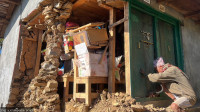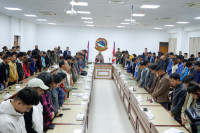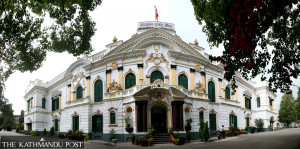Columns
Status of press freedom in Nepal
Last year revealed cracks as laws intended for freedom turned into tools of control.
Umesh Pokharel
Nepal’s media fraternity has experienced another year of progress and challenges. Journalists continued to report, investigate and raise critical voices, despite confronting political interference, legal threats and economic hardships. Against this backdrop, this article examines the state of press freedom in Nepal from May 4, 2024 to May 2, 2025, highlighting hard-won achievements, lessons learned and challenges.
Legal framework
The Nepali Constitution guarantees freedom of expression, the right to information and press freedom, but in 2024–2025, the government failed to align its actions with these promises. Although the long-delayed Public Service Broadcasting (PSB) Act was passed to transform Radio Nepal and Nepal Television into public service broadcasters, issues like political interference, governance flaws and financial dependence do not align with the PSB spirit.
The Media Council Bill raises concerns as it places media regulation under government control, restricting independent journalism. Additionally, the Social Media and IT and Cyber-security Bills introduced in 2024 propose sweeping powers to suppress dissent, with vague language and harsh penalties. Furthermore, Section 47 of the Electronic Transactions Act continues to target journalists and citizens who are critical of the government. A positive development during the period was the lift on the TikTok ban.
Media rights violation
The Federation of Nepali Journalists (FNJ) reported 57 cases of media rights violations. Most tragically, two journalists lost their lives—the highest death toll in a single year since Nepal’s civil war ended. The death of the Avenues Television photojournalist Suresh Rajak on March 28, 2025, while covering the pro-monarch demonstration shook the nation. Rajak was trapped inside a burning building set ablaze by pro-monarch demonstrators. Similarly, on November 10, 2024, journalist Suresh Bhul was brutally attacked following a minor dispute. He succumbed to his injuries the next day.
Beyond these tragic deaths, the climate for journalists grew increasingly hostile. Between May 2024 and April 2025 alone, 24 journalists were obstructed or detained, 28 were physically assaulted, 13 received threats, two were arrested and 15 faced various forms of mistreatment. Often, multiple journalists were targeted at once.
Also, impunity for crimes against journalists continues to thrive. Although the Transitional Justice Act was passed in 2024, delays in appointing officials to transitional justice bodies have paralysed progress. Similarly, the cases of journalists killed during the civil conflict—such as Nabaraj Sharma ‘Basanta,’ Krishna Bahadur Sen and Gopal Giri—were also buried.
Political influence in media
State-owned media in Nepal are found to be supporting those who hold power. They have often amplified government narratives while sidelining critical voices against the government. A glaring example came during the discussion over the Social Media and IT Bills: Rather than providing balanced coverage, these outlets either stayed silent or echoed the government’s talking points on the issue, ignoring the voices of experts and critics.
Independent media, which are expected to act as watchdogs, have also increasingly fallen under political pressure. Although the pressure they face is sometimes less overt, it significantly shapes their editorial choices. A stark example was their muted or biased coverage of the March 28 pro-royalist protest in Kathmandu, where details of the protests and use of force by the government were either underreported or framed in ways that supported government narratives. Major outlets failed to give the event and its aftermath proper coverage, delaying reports until social media outrage forced a response.
Economic pressure, financial vulnerability
With advertisers shifting their focus to digital and social media platforms like Facebook and X (formerly Twitter), traditional media have struggled to retain their financial footing. Many media outlets continue to rely heavily on government advertisements, but this dependency raises concerns about editorial independence and favouritism toward state-run media.
Journalists in Nepal still face labour rights violations such as wage non-payment, unlawful dismissals and denial of benefits. Although eporting labour rights violations involves multiple channels like internal complaints and mediation, systemic issues, underreporting, fear of retaliation and mistrust complicate resolution.
Status of the RTI
Despite the progressive nature of Nepal’s Right to Information (RTI) Act (2007) and its constitutional backing in the 2015 Constitution, realising the right to access information remains a significant challenge. While public awareness has increased, thanks to the National Information Commission (NIC) and advocacy organisations, the RTI is still underutilised by the general public.
Investigative journalists, particularly from the Centre for Investigative Journalism (CIJ), have leveraged RTI to uncover financial irregularities. However, barriers such as delayed responses, partial information and reluctance to share sensitive data from government officials continue to affect effective use of the law. The Vibrant Information Barometer Nepal study, 2024 by IREX and The Asia Foundation found that most citizens see RTI as a tool for journalists rather than a right for all, and many face ridicule or harassment when they attempt to use it. Furthermore, cumbersome procedures and a lack of accountability measures perpetuate these obstacles.
Media pluralism and diverse voice
Though some newspapers in the Tarai publish content in Maithili, Bhojpuri and Tharu, and radio stations in the hills broadcast news in local languages, Nepali language remains the dominant language of communication in media. State-run outlets have made some efforts to include local languages. Such strong dominance of Nepali language limits the public’s exposure to different cultures and ideas. Even if this linguistic exclusivity isn’t always intentional, it ends up sidelining many communities from fully participating in the media space.
Representation of religious and ethnic minorities, Dalits and other marginalised groups in mainstream media—especially in televised interviews and major news platforms—remains very low. The gender gap is also stark. Of the 9,340 journalists affiliated with the Federation of Nepali Journalists (FNJ), only 1742 are women, even as Nepal recently celebrated a milestone with women elected as Chair and Vice Chair of the FNJ.
Censorship and content restrictions
Although there is no direct censorship by the government, indirect suppression of free expression is rising sharply. Legal threats, intimidation and organised online harassment are now frequently used against critical voices. Reporting critically about politicians or celebrities with massive fan bases has become increasingly risky. Cyber armies, mobilised by political parties or fan groups, target specific media houses and journalists whenever critical reporting surfaces. Social media platforms like Facebook and TikTok witnessed a surge in racist, sexist and derogatory content.
Controversial, sexist, hate speech goes viral. Even prominent cultural figures like comedians Madan Krishna Shrestha and Hari Bansha Acharya (Maha Jodi) faced intense cyber-bullying after expressing concerns about the arrest of the Chairman of Kantipur Media Group (KMG), Kailash Sirohiya.
Conclusion
Looking back, it is clear: Nepal’s media stands at a crossroads. The past year exposed deep cracks—laws meant to safeguard freedom twisted into tools of control, voices silenced by fear and a digital sphere darkened by harassment and suppression. Journalists have paid with their safety, and sometimes their lives, simply for telling the truth. Yet amid the darkness, sparks of resilience flicker: independent platforms rise, new models of journalism emerge and a new generation refuses to be silenced.




 18.12°C Kathmandu
18.12°C Kathmandu















